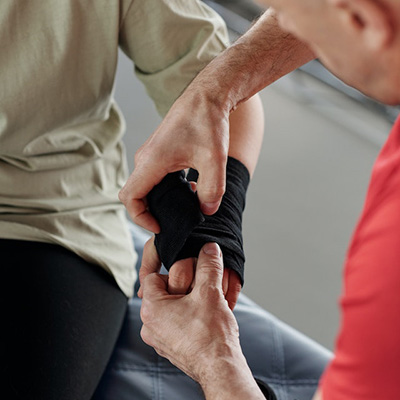Self-adhesive bandage wraps (also known as cohesive bandages or cohesive wraps) are common in first aid kits alongside other medical supplies that stick to themselves without needing gauze pads or medical tape. Self-adhesive bandage wraps are reusable, stretchy bandages that stick to themselves but not to hair, skin, or clothing. Despite their stretchy nature, self-adherent bandages are natural rubber latex-free. They are constructed of a non-woven material called coban, which is coated in a substance that enables the bandage to stick to itself.
These types of wraps tend to be more durable than standard cloth versions, as they hold their shape better over time and maintain an intact seal as long as they aren’t torn away by accident. We’re going to take a look at the many uses of this type of bandage.
Wrapping Sprained Joints
A cohesive bandage can wrap tight to keep a sprained joint (such as the ankle, knee, or wrist) stable and secure while tendons and ligaments heal. Since self-adherent wraps are soft, porous, and breathable, they can be worn comfortably for long periods. Because they don’t stick to skin, readjustment is simple.
Securing Wound Dressings
Self-adhesive bandages can also keep a wound dressing in place. It can also hold an ointment-impregnated bandage for skin care purposes. The self adhesive bandage can be taken off for access to the injury for wound care and reapplied, provided it was not contaminated with blood, pus, or other body fluids. It’s important to note that a self-adhesive bandage is non-sterile and should not be applied directly to open wounds.
Applying a Self-Adhesive Bandage Wrap
Applying the bandage roll in a spiral will provide a secure, tight fit. A clockwise spiral is standard and preferred to counterclockwise because it allows for better tension distribution and less slippage. The spiral should be tight enough that it doesn’t slip during use, but not so tight that it causes pain or discomfort for the patient. The direction of application should be consistent throughout all layers of the wrap to prevent injury from pulling on skin or muscle tissue.
Color Coded Bandages
Today, many self-adhering bandage wraps are available in different colors (other than the usual tan or beige) to allow users to distinguish between different types of injuries. Plus, brightly colored bandages are very popular with children!
Athletic Uses For Self-Adhesive Bandage Wraps
The uses of self-adhesive bandage wraps aren’t just limited to healthcare settings; they’re used on the playing field as well. It has many advantages over athletic tape. When applied without stretching it, self-adhesive bandage wraps can be applied in more layers to create more support. Since it sticks to itself but is non-stick to the skin, it doesn’t stretch and loosens over time like athletic bandage tape. It also won’t degrade over time like elastic bandages. Self-adhesive bandage wrap can also be easily torn by hand, so there’s no searching around for scissors when an ice pack or splint needs to be applied immediately.
Self-Adhesive Bandage Wraps Provide Effective Injury Support
Self-adhesive bandage wraps are an effective way to provide support for injured areas of the body. They can be used on sprains, strains, and other injuries as a wrap or a sling to stabilize the area.
They are a useful addition to any healthcare toolbox, whether in an athletic first aid kit, an ambulance, or an emergency room. You can find self-adhesive bandage wraps along with almost every type of bandage at Penn Care. Gauze bandages, water-resistant wound dressings, and even Band-Aids are available at the best prices when you shop Penn Care’s selection of medical supplies and devices.



